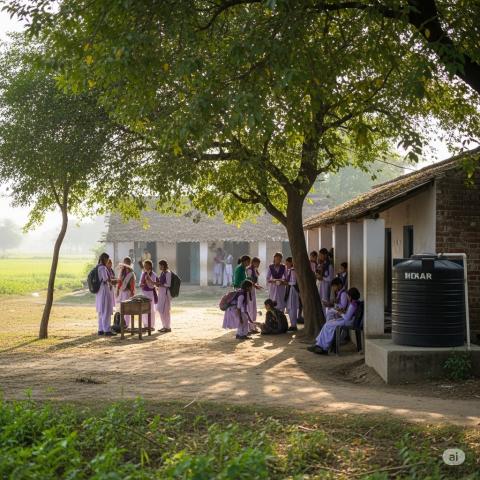
Not Just a Merger: What Closing Rural Schools Really Means
Last week, I saw a couple of news clippings about the merger of schools in Uttar Pradesh. News reports mention that over 5,000 government schools with low enrollment (less than 50 students) are slated for merger with nearby schools. Teachers have resisted this decision of the government very strongly, citing the reason that neighborhood schooling is essential for marginalized children. If they have to travel long distances, they would not be able to access education. Critics argue that merging schools will force students—especially girls—to travel longer distances, potentially increasing dropout rates due to inadequate transport and safety issues.
But this is not an isolated issue. We can see this trend across many states in India. I believe the question of school mergers is much wider and deeply connected to our economic planning. The debate about a new India was embedded in our freedom struggle. The stalwarts of that struggle were not only fighting against the British for the country’s freedom; simultaneously, they were weaving a dream of the kind of India they wished to see in the post-independence era. Since most of the schools being merged fall in rural areas—and India has witnessed strong migration from rural to urban spaces—it is worth asking: how did the founders of this nation view the rural-urban question?
“Mahatma Gandhi in his letter to Shri Jawaharlal Nehru on October 5, 1945, originally written in Hindi, expressed his views on village, in general and specially in India. He wrote “......... I am convinced that if India is to attain true freedom and through India the world also, then sooner or later the fact must be recognised that people have to live in villages, not in towns, in huts, not in palaces. Crores of people will never be able to live in peace with each other in towns and palaces. They will then have no recourse but to resort to both violence and untruth. I hold that without truth and non violence there can be nothing but destruction for humanity. We can realise truth and non-violence only in the simplicity of village life................ .” Jawaharlal Nehru, in his reply to Bapu’s letter, wrote amongst other things, that, “The whole question is how to achieve this society and what its content should be. I do not understand why a village should necessarily embody truth and non violence. A village, normally speaking, is backward intellectually and culturally and no progress can be made from a backward environment. Narrow-minded people are much more likely to be untruthful and violent.” (The Selected Works of Mahatma Gandhi Vol. IV. Selected Letters General Editor Shriman Narian. Navajivan Publishing House, Ahmedabad. pp. 98-101)”
Here we saw how Nehru, the first Prime Minister, viewed Indian villages. In the post-independence period, it was Nehru who deeply influenced India’s development trajectory, not Gandhi. And coincidentally, parties of different political ideologies continued to support this urban-centred development in India. Ambedkar, who continues to inspire millions across the globe, had a very cynical view of Indian villages. He said that the village was a cesspool of degradation, corruption, and worse.
Well, the above-stated arguments form the foundation stones of our policy decisions. Development policies in India are pro-urban, and institutions—whether schools, hospitals, or anything else—bear the brunt of their location. The economic logic of optimal resource mobilisation also strengthens the government’s decision to merge schools.
But I think we need to pause and ask—is living in a village a choice? In most cases, it is only the poor and marginalised who remain in villages, not because they choose to, but because they don’t find a supportive environment in the cities. School mergers may further compromise their already fragile situation. This is also a moment to re-evaluate the urban-centric policy push. In most cases, it has resulted in cities where we are unable to provide even fresh air and clean water—the fundamental necessities of life.
I believe that a decentralised model of development is the way ahead. In such a model, the institutions already present in villages—schools, hospitals—must be seen as critical anchors. Good schools and hospitals might actually become a reason for people to consider living in remote areas. Therefore, the school merger issue is not merely about education—it is embedded in our larger economic outlook and how we imagine the development of India.
It is not necessary that how the founding fathers visualised this nation should continue to define our choices forever. But we must re-visualise our development trajectory in light of the emerging needs of our time.
And if we consider modern wars as a reference to the times we live in, the more dispersed the settlement, the greater the security. Missile attacks cause grave destruction in densely populated areas. This is the time to also consider dispersed settlements as a strategic security decision for the country. But for that, we must provide schools and hospitals as fundamental institutions—even when the numbers are small.
In that sense, a school in a remote village is not just a place of learning—it is an act of national resilience. A commitment to decentralised development is also a commitment to peace, equity, and preparedness.
- Log in to post comments
